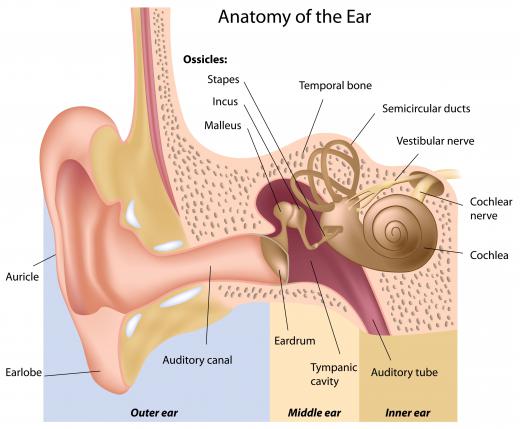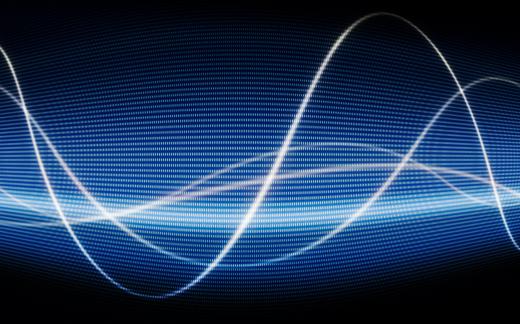What is Sound Energy?
Sound energy is the energy produced by sound vibrations as they travel through air, water, or any other space. These vibrations cause waves of pressure that, from a physics standpoint, lead to some level of compression and rarefaction; in other words, they amplify, bounce, and move as they travel from their origin to people or animal ears, which translate them into noise of varying levels. This type of energy is a form of mechanical energy. It is not contained in discrete particles and is not related to any chemical change, but rather is purely related to the pressure its vibrations cause. Most people and animals can register this sort of energy with their ears and it’s fairly easy to identify, but it’s usually much more difficult to actually harness, and though it can seem really pervasive it doesn’t actually produce much useable output in most cases. For this reason sound-related energy isn’t normally harnessed for electrical power or other human energy needs.
How It’s Generated

Anything that makes noise is generating sound energy. Vibrations, bangs, and clangs — all of these give off noise by producing waves that carry the translation of the sound from one place to another. All energy, sound included, can be thought about as the amount of work that can be performed by a given force, system, or object. In this context “work” is simply defined as the ability to cause change in a system; this can involve anything from a change in location to a change in heat energy. The amount of work that can be performed by common, day-to-day sounds is quite small, so sound is not often thought of in terms of the raw energy it contains. It does, however, exist as vibrational waves of sound, and these do cause change even if that change is small.
Measurement Basics

Most of the time people talk about sound-based energy in terms of pressure and intensity, both of which are generally measured in pascals and decibels. Sound measurements are, by their very nature, relative to other sounds that cause more or less pressure, which means that they are really only measured in comparative terms. Their speed and strength is impacted by their environment, too, as sound waves move faster through some substances than others. Under water, for instance, the same sound will often generate different energy than it would in the open air.

It’s usually also the case that this sort of energy is described on the basis of how sounds are perceived by healthy human ears. Something that produces 100 pascals of pressure at an intensity level of about 135 decibels is, for example, commonly described as the threshold of pain. What this means in practical terms is that it has the right pressure and intensity levels, commonly understood as “loudness,” to cause physical pain to the eardrums. As such, when someone says “that hurts my ears,” whether they know it or not they’re describing the sound energy more than the sound itself.
Visual Representations

In nearly all cases sound energy is represented visually as waves. It moves this way through space, but seeing it with arcs and dips the width of which represent its overall speed and strength helps to drive the point home. Physicists and others typically use a series of calculations and metrics to draw up visualizations of this sort of energy, and in most cases the distance between each peak and valley has a direct correlation to the strength and output potential of the root noise.
Perception by Humans and Animals

Sound energy is closely related to the ability of the human ear to hear, and this in many ways dictates how it’s quantified and perceived. The wide outer area of the ear is maximized to collect sound vibrations, and the energy is amplified and passed through the outer ear. It ultimately strikes the eardrum, which transmits sounds into the inner ear. Auditory nerves fire according to the particular vibrations of the sound waves in the inner ear, which designate such things as pitch and volume. The human ear is set up in an optimal way to interpret this sort of energy in the form of vibrations, and humans are usually able to translate sound waves into noises that make sense. Different animals have different ranges and are often able to hear different energy frequencies, though in most cases the actual mechanics of interpretation are the same.
AS FEATURED ON:
AS FEATURED ON:















Discussion Comments
Does sound energy echo as it bounces off a wall and comes back?
Sound travels at different speeds in different materials, probably especially at the nano-level. Why not make a nano-megaphone (seems simple enough, just a cone of something), stack those aligned into a structure (probably just a thin sheet/film)and aim them at something like a dynamic microphone that the sound powered telephone systems use?
I wonder how many decibels of sound energy it takes to power something as simple as a cell phone or laptop. I know that it takes 200 dB to make someone's brain explode so if it took more than that to power a simple everyday object, could we use it as a primary energy source one day?
yes, sound is really something. i think we can create a medium in which the energy of sound could be amplified. we should focus on the thing about a sound that generates the energy and make a device to make it higher and can make a good source of electricity. It's now the 21st century. i guess we should start finishing what our old folks started! --kurupon (philippines)
Is sound energy renewable?
if we want to generate the power at high level then how it is possible?
Is there anyone who actually tried to device a system to convert sound energy into electricity?
Some machines make noise, but others seem to hum and you can find a pitch. Can machinery be made to hum in pitch, and if so, can they be tuned? If they can be tuned they could hum in harmony.
There was an experiment done recently with microorganisms in waster water treatment. They played Mozart and the organisms were more productive. I can see both the wonder and the danger of hypnotic power in this.
But I wonder too whether the harnessing of sound energy depends upon harmonic vibration, rather than just sound. Some systems work harder on less energy when there is coordination.
Sound is converted to electrical energy in crystals. This is called the piezo-elecric effect. It is used to manufacture microphones.
sound is next to light (it travels at high speed.
i think it's possible to harness the energy from sound waves (like solar energy) because sound is everywhere. it depends only in the level of what our ears can hear. every sound that we hear is not all the same, unlike the light.
I wish there was a way. If there was a way to harness the power of sound and how energy is transferred to a substance at a frequency of breaking. Like an opera singer to a glass cup.
Nowadays, sound is increasing repeatedly because of human necessity, sounds at factory, sounds of traffic. It's increasing. Is there any way to store sound energy and use it in some form of mechanical work?
That would be something, wouldn't it? One could install a layer of sound harvesters beneath roads or place them on lampposts a few feet above the ground or something. Unfortunately, the vibrations produced by sound are very small and generally have relatively low intensity. As such, sound would not make a viable energy source.
It really is a bummer that sound produces small amounts of energy. Imagine if the energy produced was enough to be able to use it as an alternate source of power? A big city like New York could be "farmed" for sound energy and actually make something good come out of such a loud place!
Post your comments